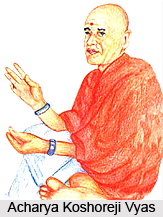 Acharya Koshoreji Vyas is a renowned saint of India. The contemporary Indian people consider and obey a very few saints and philosophers and also define them as great saints; Acharya Koshoreji Vyas is undoubtedly one of them. Acharya Koshoreji was born in the year of 1949 in such a family where getting knowledge about religion and philosophies was of maximum importance. Because of such family background, Acharyaji started his education at an early age and he was also introduced to the world of Indian philosophy in his very childhood.
Acharya Koshoreji Vyas is a renowned saint of India. The contemporary Indian people consider and obey a very few saints and philosophers and also define them as great saints; Acharya Koshoreji Vyas is undoubtedly one of them. Acharya Koshoreji was born in the year of 1949 in such a family where getting knowledge about religion and philosophies was of maximum importance. Because of such family background, Acharyaji started his education at an early age and he was also introduced to the world of Indian philosophy in his very childhood.
Acharya Koshoreji Vyas completed the study of philosophy at a very young age and then he went to Varanasi that is one of the most sacred places in the Indian heritage. After spending some good time in Varanasi, Acharyaji went on for a world tour and he toured several countries over a period of seven years. The main objective behind his world tour was to wipe out the religious misconceptions and misinterpretation of religious scriptures among people and also to promote universal peace, purity and spirituality, through giving the exact definition of the Indian philosophy.
In order to get more success in his objective of promoting universal peace, purity and spirituality, Acharya Koshoreji Vyas founded the Maharshi Vedavayas Pratisthan in 1990. He founded the institution also with the view to serve to the cause of Vedic learning. He also found the Sant Kripa Pratisthan in the year of 1997 with an aim to spread his message both among the students and the other communities. One of his famous descendants, Shri S. Navtanpuri Dhan has been performing several humanitarian works like health care, public awakening, human values, all over India under his generous guidance, at the moment. Restoring a healthy, prosperous, vigilant and peace-loving society is the most important objective in the life of Acharya Koshoreji Vyas.
This article is a stub. You can enrich by adding more information to it. Send your Write Up to content@indianetzone.com




















